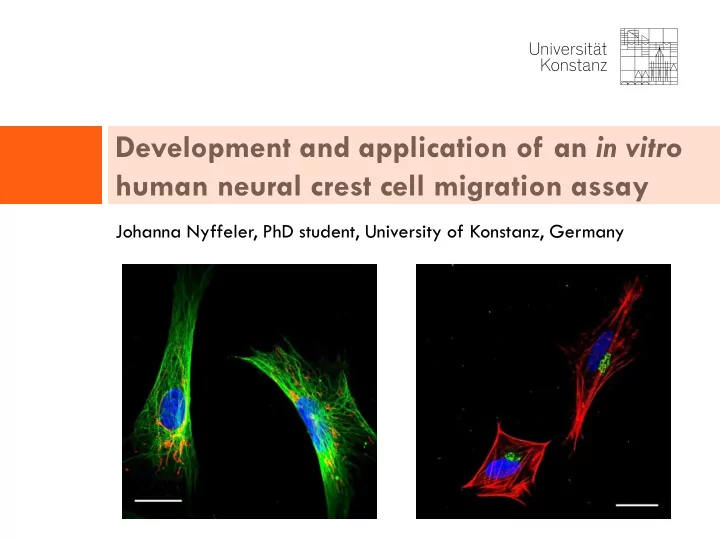

Development and application of an in vitro human neural crest cell migration assay Johanna Nyffeler, PhD student, University of Konstanz, Germany
Outline 2 1. Introduction 2. Develop a NCC migration assay suitable for high throughput 3. Application of the assay: Screen of a compound library
What are neural crest cells (NCCs)? 3 Migration Proliferation Neural crest cells Knecht et al., 2002 Differentiation into several cell types: - enteric neurons - sensory neurons Gammill et al., 2003 - cartillage & bone Delamination from - melanocytes - … the neural tube
Consequences of disturbed NCC function: Neurocristopathies 4 Hirschsprung‘s disease: - enteric neurons missing Migration - genes: RET, EDN3 triazole fungizides Treacher-Collins syndrome: retinoic acid Proliferation - craniofacial malformations ethanol cyclopamine Establish a test system for - screening - mechanistic exploration Generation of neural crest cells from human pluripotent stem cells Giorgia Pallocca
Goal: „Ring Assay“ 5 cMINC assay MINC assay Zimmer et al. 2012 • low throughput • high throughput - varying scratch widths - experimenter-independent - manual image acquisition - automated image aquisition
Assay Development 2. ALTEX. 2017;34(1):75-94
Assay Principle 7 stopper day -1 day 0 day 2 Calcein specific effect on migration cytotoxic 2 mm migration measure Calcein viability measure 6.35 mm
Assay setup with controls: 8 endpoint-specific control known positive control 48 h 24 h “24 h“ assay able to detect specific NCC migration-inhibition
Testing new compounds 9 unspecific specific proliferation-inhibitor new „ hits “ identified proliferation as confounding factor
Proliferation in the 24 h setup 10 compounds from group III
Prediction Model endpoint-specific control positive control unspecific compound 11 Migration inhibition at EC90 V /EC90 M EC90 V /EC75 M EC90 V [%] taxol 24 taxol 4.79 91.0 8.3 4.60 PCB180 CdCl 2 CdCl 2 retinoic acid 66.9 PCB180 6.6 PCB180 4.43 56.6 4.8 2.31 CdCl 2 LiCl LiCl 55.3 AraC 3.9 retinoic acid 2.20 LiCl 53.4 CytoD CytoD 3.6 CytoD 2.13 taxol 49.6 retinoic acid 3.1 As 2 O 3 1.51 As 2 O 3 2.8 acrylamide 1.50 As 2 O 3 40.9 colchicine 40.4 acrylamide 2.7 colchicine 1.37 acrylamide 39.9 staurosporine 2.6 staurosporine 1.11 colchicine 2.1 triton X-100 1.06 triton X-100 29.6 AgNO3 27.6 aphidicolin 2.0 AgNO3 1.05 staurosporine 27.6 AgNO3 1.5 L-homocysteine 0.70 MG-132 1.5 MG-132 0.69 AraC 17.9 MG-132 16.9 triton X-100 1.4 AraC 0.43 aphidicolin 13.7 L-homocysteine 0.98 aphidicolin 0.23 L-homocysteine 9.3 Viability ≥ 90% and migration < 75%
Conclusion part ‚Assay setup ‘ 12 • advantages of the cMINC assay: o experimenter-independent o software for automated image analysis o high reproducibility o medium to high throughput • broad set of compounds tested: tool compounds, positive controls, negative controls, etc... • special focus on proliferation • preliminary prediction model
Application: Screening 3. Arch Toxicol. 2017, in press
Procedure 14 „NTP80 - list“ (75 compounds) Screening cMINC assay single concentrations negative flame controls 5 retardants 12 viability > 85% NO industrial AND chemicals 9 migration < 80% YES Hit confirmation testing polycyclic pesticides concentration-response curves aromatic 17 compound hydrocarbo is ns 17 „negative“ viability > 90% drug-like AND compounds NO migration < 75% 15 YES compound is a „positive hit “ Follow-up assays
Screening 15 26/75 potential positive compounds
Hit Confirmation 16 • 23 of 26 compounds confirmed • hits fall all into 3 classes: - 10 flame retardants - 7 pesticides - 6 drug-like compounds • many halogenated compounds i.e. organochlorines
Follow-up assays 17 Manual cell tracking Transwell migration all compounds confirmed but not identical results
Conclusion part ‚Screening‘ 18 • assay suitable for a screening • new migration-inhibiting compounds detected especially organochlorine and organophoshorous compounds • compounds confirmed in other migration assays
Take home messages 19 NCCs are an embryonic cell type & 1. target of developmental (neuro)toxicants NCC migration can be assessed in vitro 2. cMINC assay is promising to screen for D(N)T compounds 3. Be careful when setting up an assay! 4. - use positive and negative controls - confounding factors (i.e. proliferation) different assays test for different biological processes 5.
THANK YOU! Marcel Leist Xenia Dolde Tanja Waldmann Heidrun Leisner Christiaan Karreman Giorgia Pallocca Alice Krebs
Recommend
More recommend